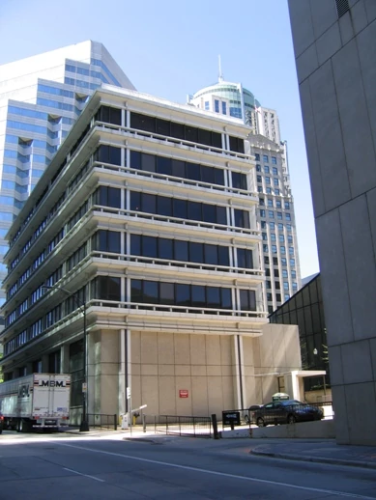
Home Federal Savings & Loan Building
(ca. 1967)
The one-time headquarters of a century-old local bank offers a unique example of Modernist architecture in Charlotte’s financial district.
139 S. Tryon St., Charlotte, NC 28202
The Home Federal Savings and Loan building is a rare surviving example of a post-World War II mid-sized Modernist office building in Charlotte’s center city. Completed in 1967, the seven-story building reflected both the Charlotte-based bank’s growing status as a lending institution in the heart of the city’s booming financial district and the city’s emergence as a thriving regional metropolitan center and financial hub in the postwar decades.
Property Quick Links
Samuel Wittkowsky (1835-1911), a Prussian immigrant of Jewish descent who owned a successful local general merchandise store, founded Home Federal Savings and Loan as the Mechanics Perpetual Building and Loan Association in 1883. Backed by local investors, Wittkowsky’s Association initially offered only home mortgages. Over time, it expanded its operations to include lending services for homebuilders and contractors, as well as saving accounts for individuals. Mechanics Perpetual replaced its state charter with a federal charter in 1943 and changed its name to Home Federal Savings and Loan. The bank experienced significant growth in the mid-1900s, with assets increasing from $3,000,000 in 1943 to $19,000,000 in 1955. Between 1950 and 1954, Home Federal made 5,700 loans to homebuyers and building contractors. In 1962, Home Federal opened Charlotte’s first savings and loan branch, strategically located in the new Park Road Shopping Center within the city’s booming southeastern outskirts.
In 1955 Home Federal Savings and Loan relocated from the 100 block of East Fourth Street to the Buford Hotel building at 139 South Tryon Street. In the mid-1960s, the bank razed the hotel to make way for its new headquarters. In the meantime, Home Federal’s success continued, as evidenced by the 10,000 home loans (amounting to nearly $400,000,000) and loans of $140,000,000 to homebuilders and contracting firms it made over the 1970s. By the 1980s, the bank ranked among the state’s top five savings and loan associations in total assets, ultimately making it an attractive acquisition target for First Charter Bank of Charlotte in the late 1990s, after which the bank’s offices were relocated elsewhere on South Tryon Street.
Like other Modernist structures, the Home Federal building reflects a postwar optimism that industrialization was the answer to contemporary needs and aspirations in its use of abstract sculptural forms that expressed function while employing new materials and technology. It also stands in sharp contrast to the rectangular, steel-and-glass designs that marked the city’s Modernist skyscrapers. With its exposed rough-surfaced concrete walls, projecting sunshades/balconies, and connection to the landscape, the Home Federal building displays Japanese-inspired elements of design unusual for downtown Charlotte.

